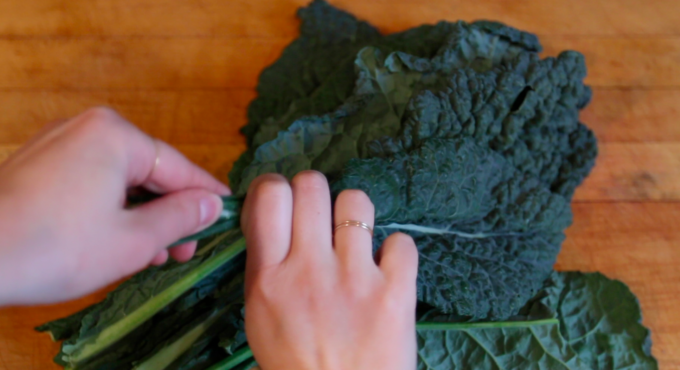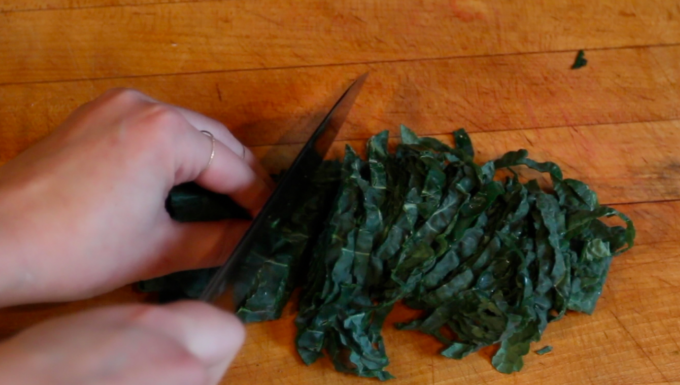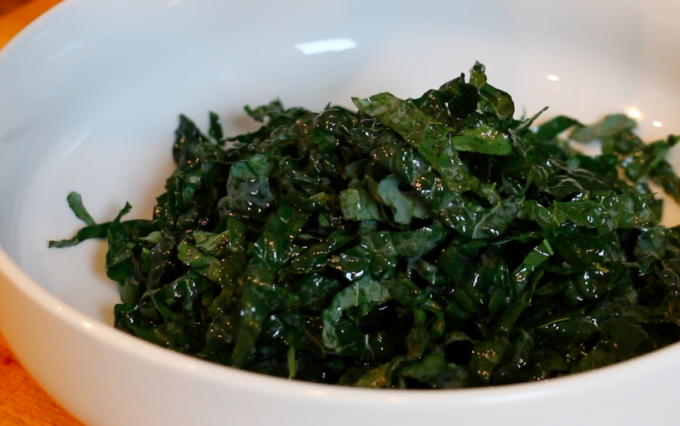Someone once told me you have to soak kale for an hour and allow it to dry out on a kitchen towel for another hour before chopping it, which is why I spent many years avoiding it. Ordering kale in restaurants felt like such a luxury. Since then I’ve obviously done a little more research and that method has since been debunked, however there was definitely a time in my life when I thought prepping kale was a ridiculously arduous task. This got me thinking; what if other people had received similarly faulty and perplexing information about kale prep and perhaps this was why our clients often ask for extra prepped kale? So, today, we’re here to demystify the steps to perfectly prepped kale. And I promise it’s not as complicated as you’re making it out to be.
The things I’ve learned about prepping kale: buy a salad spinner, the stems are not really edible (unless you cook them or chop them finely), roll the leaves up like a sushi roll or burrito, slice it as thin as possible and massage it just a little with some oil and salt or extra vinaigrette.
It’s no surprise that kale is one of our favorite greens, not only for it’s health benefits but it’s heartiness as well. Prepped kale is a great option for people that like to keep things in their fridge all week. Our team preps it out and uses it as the last salad on our client’s weekly menus because it stays green and crunchy for a long time, sometimes as long as a week and a half. But if you’ve eaten a bad batch of kale you know that there’s nothing worse than getting a solid chunk of stem in your mouth. This is why kale prep is important.

To de-stem kale, hold the kale stem with one hand and strip the greens with the other. Next, lay the kale flat on your cutting board with with the tip facing you. Roll it up from front to back and hold it in place with one hand. With your knife slice the kale thinly in one fluid motion without sawing at the greens (in chef terms this is called a chiffonade).

Next it’s time to rinse. Kale is one of the dirtiest greens with lots of nooks and crannies so salad spinners are pretty much a necessity if you want a good clean and don’t feel like spending a good portion of your prep time straining and blotting your greens with paper towels (been there). We like to wash our kale after it’s been stripped and chopped because it’s easier to transport from board to spinner. Be sure not to over handle the kale because it will start to soften and wilt. This is only important if you wish to store your prepped kale in the fridge for as long as possible.
If you’re planning on serving it right away, you’ll probably want to massage it. If you don’t think you’re a fan of kale, it’s probably because you haven’t massaged it. This is a technique for softening kale to make it easier to eat and gives the dressing a better grip. You can do this with a little vinaigrette or a sprinkle of olive oil and a pinch of salt. Don’t get crazy with it, once you feel your kale start to break down stop.

If you’re like me and you hate throwing ingredients away, you’re probably wondering what to do with the leftover stems. These are great chopped up and sautéed in a stir-fry or frittata. Making a soup? Add it in with your onion, celery, etc. for a little extra crunch.
For this video we used lacinato kale (dinosaur kale or Tuscan kale) but you can use with technique for any variety of kale. You can also use this technique when you’re prepping chard or collards.
Once you’ve mastered your prep, here are a few of our favorite kale salads. Hope this how-to opens you up to a world of delicious-kale-salad-possibility!
With love, Charlotte
- Kale Salad with Pecorino and Walnuts – https://smittenkitchen.com/2013/08/kale-salad-with-pecorino-and-walnuts/
- Kale and Pecorino Salad with Ricotta Salata (we usually swap out crumbled goat cheese for the ricotta salata) – https://smittenkitchen.com/2014/03/kale-and-quinoa-salad-with-ricotta-salata/
- Raw Tuscan Kale Salad (add avo) – http://www.101cookbooks.com/archives/raw-tuscan-kale-salad-recipe.html
- Kale Market Salad – http://www.101cookbooks.com/archives/kale-market-salad-recipe.html
- Northern Spy’s Kale Salad (a good “gateway” kale salad with all of that cheese!) – https://food52.com/recipes/15584-northern-spy-s-kale-salad
- Lamon-Garlic Kale Salad (add avo) – https://cooking.nytimes.com/recipes/1015707-lemon-garlic-kale-salad
- Kale Salad with Dates, Parmesan and Almonds (make extra vinaigrette) – http://www.epicurious.com/recipes/food/views/kale-salad-with-dates-parmesan-and-almonds-51137020